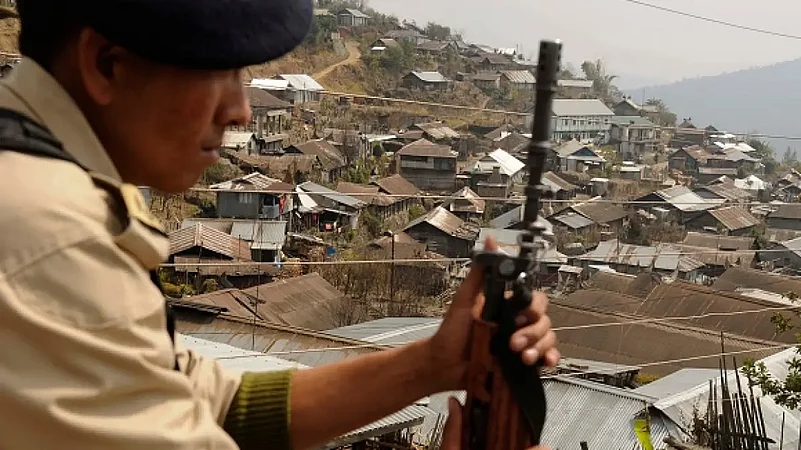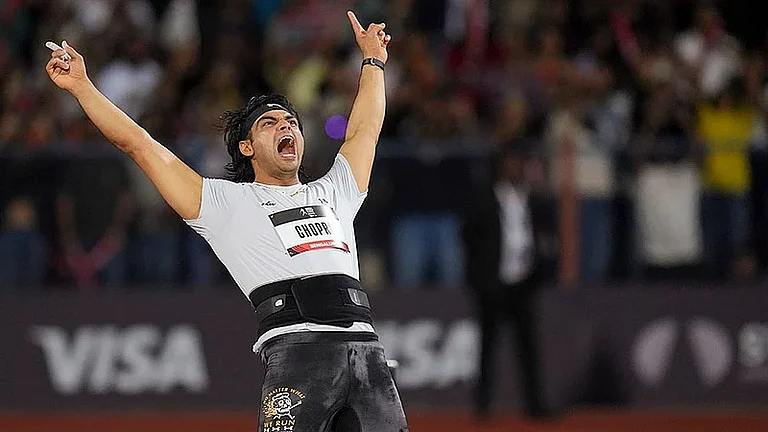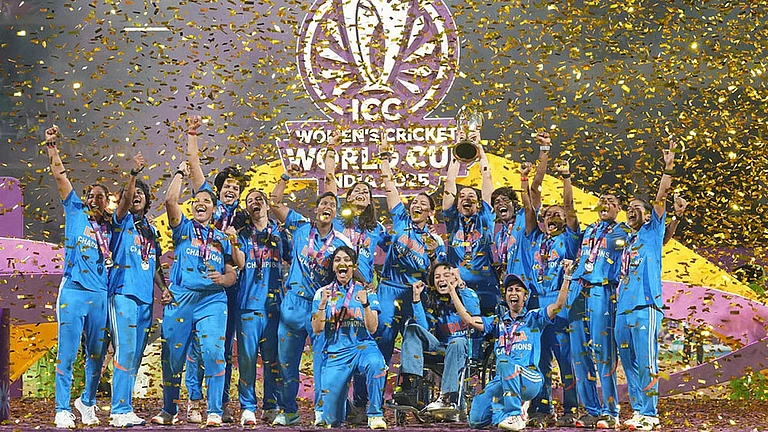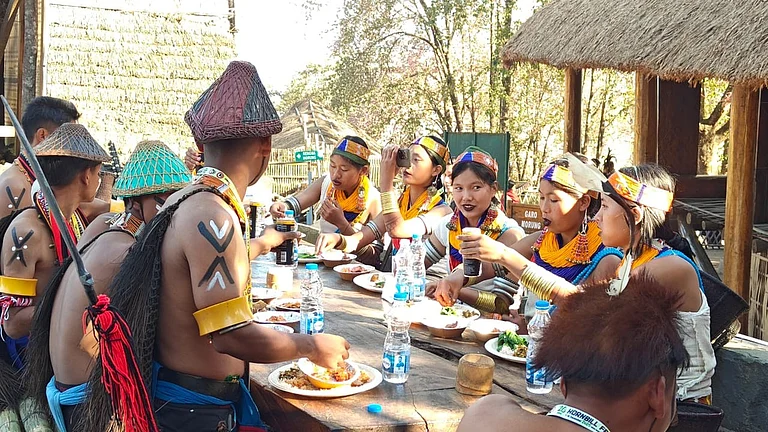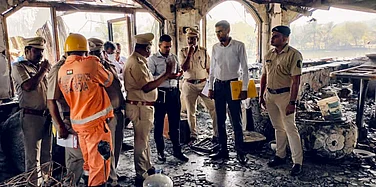From the Kohima bus stand, the road on the right takes an upward turn and leaves the hills behind. Heavy fog and cold wind give a chilly wintry feel even in an August summer. The sun gets softer as the road goes up, making the Oking Hospital Road a perfect track for a morning walk. After crossing the Baptist High School, as one approaches the lone house on the right edge of the hills, the mood changes. High gates, security men with sophisticated weapons and an entry-only after appointment, makes one wonder what this house, which looks like just any other beautiful houses in the capital city of Nagaland, contains.
It was 10 am. In the living room, a senior lady is wearing a shawl, skirt, and black shoes, and having a discussion with her colleagues. She is speaking slowly in Angami, a Tibeto-Burman language spoken by around 1, 50,000 people in the state. She looks fragile yet powerful. People will find it hard to imagine that this elderly lady was once a Naga rebel, who has spent over 40 years in exile within caves at Burma to the Britain countryside. She is Adinno Phizo, 90, the daughter of fierce Naga rebel Angami Zapu Phizo, regarded as the Father of the Nagas.
Angami Phizo is the man who gave Nagaland an Independence Day on August 14, 1947, a day ahead of India’s Independence. He also held a Plebiscite of the Nagas in 1951 a year ahead of India’s first general election where 99.90 per cent of Nagas gave a thumb impression for an Independent Nagaland. Tension brewing from Camp Hebron, the headquarters of the National Socialist Council of Nagaland Isak (ground report) in Peren district, about 100 km from Kohima, has engulfed the nook and corner of the state. Like Adinno’s house, closed-door meetings are going on inside the offices of student organisations, civil society groups, and rights activists. Hushed discussions take place in taxi stands, markets, and tea shops. The footfall of journalists from different parts of India to Kohima has increased in the past few days. Everyone seems a little worried.
The source of the tension is the growing dissatisfaction of NSCN (IM), the largest Naga Insurgent group at present, on ceasefire against the Indian government. August 2022 marks 25 years of the ceasefire agreement between the rebel group and the Indian government. Even after over 80 rounds of talks since 1997, the parties are yet to reach a mutually agreed peace accord.
The completion of 25 years has made Nagaland restless. The strongly worded press statements of NSCN (IM) affirming its stand for a separate flag and constitution, Th. Muivah’s address about Camp Hebron on Naga Independence Day claiming 25 years of the ceasefire as meaningless without a solution, is worrisome for the state which has seen one of India’s oldest armed struggles from the 50s till the 1997 ceasefire brought moderate peace in the region.
Adinno, who is the President of the Naga National Council (NNC), the first Naga political organisation founded in 1946, has given most of her life to the struggle like her father Angami Phizo. She had to leave Nagaland in 1966, following increased crackdown of Indian security forces upon the Naga rebels and returned to India in 2013, after a 40-year exile.
Naga National Council, today a small organisation, does not have any connection with the NSCN (IM) headed by Th. Muivah, who was one of the youngest leaders when he joined NNC in 1964. “How could a man from Manipur interfere in the matters of the Nagas?”, Adinno was referring to Th. Muivah, a Tangkhul Naga from the Ukhrul district of neighbouring Manipur. Her translator was quick to translate it from Angami to English for Outlook.
Th. Muivah was among the first Naga rebels who went to China to train in sophisticated weapons to fight against India. He formed NSCN out of a few leaders from NNC in 1980 as he fell out after NNC signed the Shillong Accord with the Indian government in 1975 and accepted the Indian constitution. Today, NNC and NSCN (IM) do not see eye to eye.
“We have not demanded anything from India. Other political groups are making demands as they do not have the Naga National Stand (that is complete sovereignty). Why would the Nagas who were never a part of India demand Independence from India?”, Adinno asks, between small sips of tea.
Back in Camp Hebron, about 100 km from Kohima town, NSCN (IM) leadership were busy preparing for the 25th anniversary of the ceasefire. Camp Hebron, which otherwise is welcoming of journalists and researchers working on the Naga struggle, seems unusually reserved. “Right now, Camp Hebron will not talk to any journalists. Whatever it has to say it would be through a press statement. Don’t think we are not welcoming of you, just that it’s not the right time to say anything to anyone”, says an insider, when Outlook tried to access entry to the camp.
On August 14, while celebrating 76th Naga Independence Day in Camp Hebron, Th. Muivah had said, “Our future is in our decision to stand firm on our sovereign right, not in submission to the aggressors. Our no to the dictation of the enemies will save our history.”
***
Nagaland is divided into mainly two groups of leaders. One, who still believes in the possibility of an independent nation after altering the international boundaries of India and Myanmar. The other thinks the rebels should agree to what the Indian government has to offer to the Nagas, that is autonomy within the Indian Union.
Dr SC Jamir, a veteran statesman and five times CM of Nagaland falls in the second category. Jamir, 90, considered the Architect of Modern Nagaland, is the lone surviving signatory of the 16-point agreement in 1960 signed between the Naga People’s Convention and then Prime Minister Jawaharlal Nehru, which led to the formation of Nagaland as the 16th state of the Indian Union. Jamir has been a target for rebels during his tenures, and escaped the attack of separatist rebels, four times now. He now lives in a farmhouse in Dimapur town, behind Nagaland Police Reserve and 35 km from Camp Hebron. From India’s first Minister Jawaharlal Nehru till the current PM Narendra Modi, Jamir enjoys a certain authority over the Naga issue in critical talks.
On being asked what was discussed in the last meeting in May 2022, Jamir says, “The Home Minister and the Prime Minister are very clear that they will not agree on a separate flag and constitution for the Nagas. In fact, the Nagas also want autonomy incorporated into the Constitution. My only suggestion is that whatever is decided should be put into action. You cannot keep lingering for so many decades. Who would not want a peaceful North-eastern region to implement the Act East policy? All these infrastructures, construction of roads are for what?”
It’s been seven years since NSCN (IM) signed a Framework Agreement with the Government of India. The Modi government termed the 2015 Agreement as ‘historic’ while recognising the ‘unique history’ of the Nagas. The Agreement does not refer to a separate constitution or a separate Naga political flag. However, NSCN (IM) has been saying that a peace accord based on the Agreement must include these two elements. A final peace accord is awaited because of the Indian government’s unwillingness to accept this demand.
Jamir, who has been an observer of the entire Naga political struggle, says, NSCN (IM) should keep the sanctity of the Framework Agreement. “As an elderly person I want to tell those fighting for an independent nation that we appreciate whatever you have sacrificed. But let’s be proud of whatever is possible under the present circumstances as well. Tell the Naga people that we have tried for so many years, but this is only what’s possible today under the present political environment,” he tells Outlook.
Back in Kohima, Kegwayhun Tep, President of the Naga Student Federation (NSF) is sitting in his office in Naga Club Building in Oking. The student body, formed in 1947, is the largest representative of Naga youths. NSF has never shied from wanting complete sovereignty of the Nagas. Tep jibed about Naga leaders who are mum on Naga sovereignty, by saying, “Some leaders don’t participate when we talk about the aspiration of the Nagas. They are talking about the Naga issue as an Indian. But we must talk as a Naga and not as an Indian. We are different people and that is something even the Indian government has accepted when it admitted that the Nagas have a unique history.”
The peace talks between NSCN (IM) and the Indian government hit a dead end when two years after the signing of the Framework Agreement, the centre invited the Naga National Political Groups (NNPGs), a confederation of seven Naga rebel organisations, for talks. It led to the signing of ‘Agreed Position’, which according to NNPGs’ press note means, “GoI recognises the political and historical rights of the Nagas to self-determine their future in consonance with their distinct identity.”
Unlike NSCN (IM), the NNPGS are not demanding a separate flag and a constitution. The NSCN (IM) has since been alleging that the Indian government is misinterpreting the Framework Agreement of 2015. In March 2022, in Washington, while addressing the General Assembly of Unrepresented Nations and People’s Organisations, Th. Muivah, claimed that the “framework agreement” says that Nagas and India will co-exist as two entities, sharing a “sovereign power”. It means “the Nagas will not merge with the Union of India but will co-exist with India,” explains Th. Muivah. He also says that the Indian government has stated that Nagaland and all its natural resources belong to the Nagas. It also recognises the legitimate right of territorial integration of all Naga areas under one political roof.
But in April 2022, when A.K. Mishra, the centre’s interlocutor visited Th. Muivah and other leaders in Camp Hebron, he stated that the government would not budge about allowing a separate flag or constitution for the Nagas. Except during cultural activities, a separate flag will be used. The two different perspectives stand as a deadlock in converting negotiations into an accord.
According to Neingulo Kromei, a rights activist and the General Secretary of Naga People’s Movement for Human Rights (NPMHR), sidelining the NSCN (IM) and negotiating with a different group like NNPGs is a strategic move of the Indian Government to delay the peace process.
Inside Kromei’s house near the Axis Bank building in Kohima Town, some rare photos of Angami Phizo, Th. Muivah, 1951 Plebiscite, etc., occupy the wall. He has also kept the photos taken with Prime Minister Atal Bihari Vajpayee and Narendra Modi, during their discussions of the Naga issue. “Since the beginning of the movement in 1946-47, the political accession, the 1951 public referendum where 99.9 per cent wanted an independent Nagaland, etc… is still the same. But over the years, different categories of people have come to the stage. Like the privileged class for instance, which does not want to sacrifice their comfort. These people say they want a solution that is not originally based on the principles of the Nagas,” Kromei tells Outlook.
Kromei, who keeps raising the Naga issue in international forums like the United Nations, feels the main conflict is that the Indian government has created two classes of people having two different schools of thought. “But we say, keep the peace process, and keep negotiating. Nobody wants violence or the pre-ceasefire situation.” ‘If war is the answer, then it must be a very stupid question’, says the wall painting in his living room.






